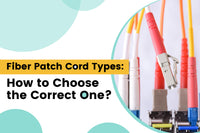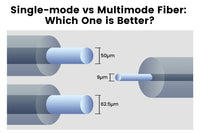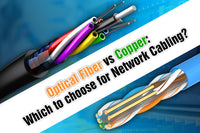PC vs APC vs UPC Connector: A Technical Comparison
Contents [show]
Fiber optic cables have been widespread in people’s home and office networks. Have you ever bought fiber patch cords or fiber connectors? If you have, you can often hear of “LC APC, SC UPC” and other product descriptions with the word PC, APC, or UPC. What are the differences between these polish types? This post will dive into the technical comparison among PC, APC, and UPC connectors.
Basic Introduction
What part of fiber connectors do PC, APC, and UPC refer to? In brief, they refer to the polishing type of the ferrule. As the picture shows, the ferrule is the housing for the inside fiber. When the fiber threads through the connector, the reflected light will affect the signal. To reduce signal loss, engineers have invented ferrule polishing technology. The ferrule is polished to a precise angle to minimize signal loss and maximize data transmission speeds. We’ll introduce three connector polish types in the following content.

PC Connector

PC connector stands for the fiber connector that uses the physical contact polishing technique. The history of PC connectors can date back to the 1980s, the oldest style among the three fiber connectors.
It looks like the PC connector has a flat end, but in fact, it has a small taper around the fiber end. The fiber-end surface of the PC connector is polished to a slightly spherical shape to reduce the air gap between the two fibers, and this smaller air gap helps reduce optical return loss (ORL). The return loss of PC fiber connectors in single-mode applications is about -40dB, which is higher than that of flat fiber optic connectors (-14dB). PC connectors are often used on OM1 and OM2 multimode fiber and are widely used for telecom equipment, but it has gradually been outdated and replaced by UPC connectors.
UPC Connector

UPC connector (ultra physical contact connector) is an enhanced version of PC connector and quickly becomes the popular polish type. As the name implies, the ultra-physical contact still has a spherical surface but features a smaller curve.
The UPC connector has a better fiber surface finish with a better and extended polishing technique. The UPC connector has a lower back reflection and better optical return loss ( -50dB or higher) than the PC connector.
UPC connectors are the most commonly used and often applied in high-demand systems such as digital TVs and data systems. But please note that very frequent connection and disconnection can cause signal degradation of the fiber end.
APC Connector

APC connector refers to an angled physical contact connector, and it was developed for a lower back reflection. The end face is polished at an angle of 8° to stop the reflected light from going back to the source.

APC connectors can be disconnected or connected repeatedly without connector performance degradation. But it should be paired with other angled physical contact connectors because of its angled ferrule end face, or it will cause great insertion loss. The APC connector has an optical return loss (ORL) of -60dB or higher.
PC vs APC vs UPC: What’s the Difference?
The apparent difference among these three polishing types is the fiber end face. PC and UPC connectors are designed with no angle, but APC connectors have an 8° angle end face. Ferrule is so small that it could be difficult to identify what polish type of the connector is. How can you differentiate UPC from APC? Color coding can be an easy way to tell them apart. They have slight differences in color code. For example, UPC connectors are often blue-colored, and APC connectors are usually green.
Before knowing the performance differences among PC, APC, and UPC, you should know the meaning of insertion loss and return loss. Insertion loss means the signal loss due to the insertion of a device in a transmission. The insertion loss can be affected by many factors, including absorption, mismatch, and air gap. Return loss refers to the amount of light reflected to the source, measured in negative decibels (dBs).
| Fiber Connector Types | Return Loss |
APC
|
-60dB |
UPC
|
-50dB |
PC
|
-40dB |
In the past, it can be difficult to achieve low insertion loss using APC connectors because of their angled end face, but with the development of the connector technique, the insertion loss of APC is very close to that of PC and UPC connectors. As for return loss, APC connectors feature the lowest back reflection. The back reflection is a concern for single-mode fiber, so APC connectors are mainly used for single-mode applications.
Tips: The higher insertion loss and lower back reflection make a better connector performance, and APC is the best among these polish types.
PC, UPC, and APC connectors also have different applications based on their performances. For example, UPC connectors are often used for data systems, and PC connectors are for telecom equipment. While APC connectors are often found in applications such as RF, FTTx, and CCTV.
Final Thoughts
Knowing polish types is very essential for the best performance of fiber optic cables. If you have a low requirement for return loss, UPC and PC connectors are suitable for you. But if you have a higher need for high-precision optical fiber signaling, APC should be your first choice.
For more information on this topic, you can keep up on our blogs. While VCELINK offers general and basic information for our customers and other visitors to the website, it’s not professional advice.






COMMENTS